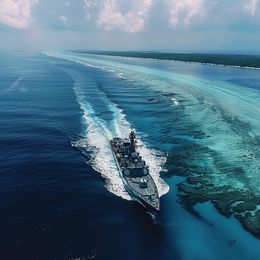Remember the guns of Navarone that threatened all the Allied shipping that passed though a narrow strait, in the Alistaire Maclean novel and film? It needed a team of the toughest British, Greek and American commandos to sneak in and destroy the guns and secure the seas. Maybe fiction, but it showed us the kind of threat that a force in control of a choke point can project in sea warfare.
A choke point is to sea warfare (there are choke points on terra firma martia, too) what a high ground is to land warfare. Military Machiavellis say, you need eight-to-twenty times the force to dislodge an enemy sitting on high ground with a machine-gun, a pair of binoculars and a good dog.
More, I would day. Look at Siachen. With all their snow-trained Northern Light Infantrymen and Frontiersmen, the Pakistan generals haven’t dislodged about a brigade of our boys sitting like frozen colossuses on the Saltoro heights for the last 40 years. For two reasons. One, our boys are tougher and braver, as we would like to believe. Two, our commanders are smarter. They knew way back in 1984 that the only way to hold Siachen was to occupy the higher peaks.
Flip the coin, and you get Kargil. It took more than two infantry divisions, several score batteries of Bofors guns spewing thousands of 155-mm shells, and several squadrons of MiGs, Mirages and Mi-17s to evict a few hundred unwashed insurgents and uniformless Pakistani troops sitting in a few sangars of rubble atop the Kargil, Dras and Batalik heights, exactly a quarter century ago. That wasn’t 1:8 or even 1:20.
Not much different is a choke point in sea warfare. With a few long-range guns and missile batteries, anyone sitting at a choke point can threaten all the shipping that falls within his firing range. And believe me, the seas around us are dotted with such Navarones. None with the kind of craggy hills for a Captain Mallory to climb (thank God!), but there are scores of chapati-flat islets that offer ideal gun positions and pirate hideouts.
Many of the people-less islands of Lakshadweep and the Maldives could turn into mini Navarones if somebody holds them with force. Our bombers and destroyers may take them out, but they can still bring global commerce to a standstill for a few days.
Exaggerated? No, if you get an idea of the kind of commercial shipping that passes though just one choke point that lies amidst our sovereign territories. All the ships carrying all the cargo and crude that are being traded between Europe, Africa and the Middle-East on the one side and South Asia, Southeast Asia and the Far East on the other, pass between two India-owned islands. I am talking of the 200-km wide Nine Degree Channel that separates our Kalpeni and Suheli Par from our Minicoy and through which 12 ships pass every minute.
The Nine Degree Channel is one of the nine choke points spotted by maritime strategists in the Indian Ocean, the others being the Strait of Hormuz, the Suez Canal and the Red Sea, the Strait of Bab-el-Mandeb and the Horn of Africa, the Malacca Strait, the Lombok Strait, the Sunda Strait, the Six Degree Channel, and the Cape of Good Hope.
We can’t take chances. Mohamed Muizzu may have kicked out about a hundred of our boys from the Maldives. But we are positioning more of them just 50 miles off. Last week the government gave the go-ahead to build a military airbase in Minicoy and to extend the airfield on Agatti.
prasannan@theweek.in


